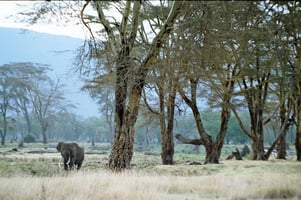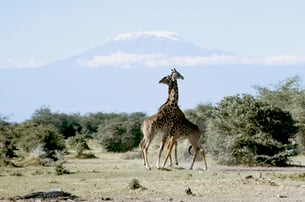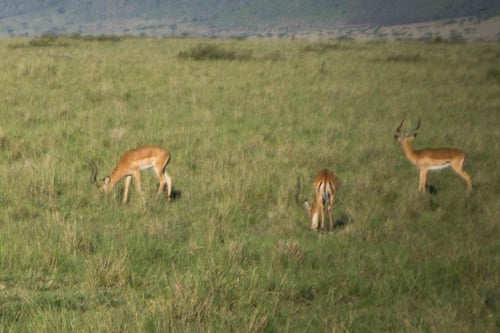Subscribe for Updates

By Eugene C. Roehlkepartain, Ph.D, Senior Scholar, Search Institute
I spent most of my childhood near Arusha, Tanzania, the launching point to visit many of the world’s great wildlife sanctuaries (many now threatened). In a matter of a few hours, we could visit half a dozen world-renowned parks such as Ngorongoro Crater, Amboseli National Park, and, with a bit more time, Serengeti National Park.



Each year, a few Saturdays and school breaks were spent rising early and driving our Peugeot 404 station wagon to one of these wildlife sanctuaries to scout for elephants, giraffe, lions, wildebeests, cape buffalo, zebras, hippo, and lots of pesky monkeys and baboons. Sometimes we’d see cheetahs and rhino. But rarely would we spot a kudu, and only once or twice did we even glimpse an elusive leopard.
If you want to see some of the less obvious wildlife (it’s hard to miss elephants or massive herds of wildebeests, but you can!), you have to slow down, pull off, and stop. You need a seasoned guide to show you where to look and what to look for. Then you wait, watch, and listen.  At first, it seems nothing is happening. Nothing is there. At some point, if you’re fortunate, the brush rustles. Stay quiet. Watch. Listen. In time, you may sight a kudu or a tiny Kirk’s dik dik.
At first, it seems nothing is happening. Nothing is there. At some point, if you’re fortunate, the brush rustles. Stay quiet. Watch. Listen. In time, you may sight a kudu or a tiny Kirk’s dik dik.
These childhood adventures came back to me while poring over the findings from a soon-to-be-released qualitative study of developmental relationships in churches, mosques, and synagogues. Some may whiz by these institutions, most with declining memberships, assuming they are relics of a bygone era. But like scouting for the more skittish wildlife, you rarely know what a community is really like if you don’t slow down, pull off, stop, and listen.
That’s what my colleagues* and I did with 13 churches, mosques, and synagogues of different sizes and cultural backgrounds in the Midwest and Southern United States in a two-year project supported by the Lilly Endowment. Before the coronavirus pandemic, we shared meals, attended their services, and spent time in conversation with youth, parenting adults, and congregational leaders, both clergy and lay. We were most interested in how young people did or didn’t experience developmental relationships in these diverse faith communities. And if they did, who were those relationships with, and how did they shape young people’ lives, faith, and spiritual development?
Relationships in Faith Communities
We’ll share the complete study findings along with some tools to apply the findings in April. Here are three nuggets as a preview:
- Many of the young people we talked with do, in fact, experience rich developmental relationships within and beyond their church, mosque, or synagogue. Those relationships play a vital role in growing their faith and spiritual lives. Each of the five elements of a developmental relationship came through clearly in our focus groups, with each element infused with the specificity of the language and practices of each faith tradition. As is often the case, we heard the most conversation about Express Care, Challenge Growth, and Provide Support. There was less about Share Power and Expand Possibilities. But all five elements were present in each congregation and each faith tradition.
- Often the things that mattered weren’t the massive events (like the impressive wildebeest migrations, if you will). Those were fun and memorable, to be sure. For many young people, their faith and spiritual lives were most shaped by the individual, sometimes brief, low-key comment, question, or prod from someone they had known for a long time that was particularly significant. Or sometimes they were the persistent, consistent, quiet, and affirming presence of another congregant—often of another generation—in their life across years or decades.
- Finally—to stretch the wildlife viewing analogy a bit—the leaders and parenting adults were able to see a lot more potential for deepening relationships intentionally when we asked if the Developmental Relationships Framework would be useful as a guide within their particular faith traditions. Some saw ways they might contextualize or tweak the framework to make it more specific to their tradition, all said they could “see more” in their relationships as opportunities for nurturing faith, spirituality, and thriving with the framework as a guide.
Is Our Picture Too Rosy?
Sometimes when we have shared some initial findings with groups of religious leaders, they have expressed skepticism. The study seems, they say, to paint too rosy of a picture of relationships in congregations. In fact, gaps in deep, mutual, and well-rounded relationships within congregations may be one of the key drivers for why young people stop participating in a religious community (see, for example, Lysiak et al., 2020). We have responded in three ways:
First, we focused our qualitative study on unpacking the rich dynamics of relationships that young people experience within the diversity of 13 faith communities. We were not trying to quantify how much young people who are part of faith communities each experience developmental relationships as part of those communities. So, the study wasn’t intended to be representative, and it intentionally focused on youth who are connected to a congregation.
Those choices left some important questions unanswered, such as the prevalence of developmental relationships among youth who are part of congregations? And how is faith or spiritual development nurtured among youth who are not part of a religious community? Those are important questions that require additional research.
Second, in some faith communities (we don’t know how many), developmental relationships are likely growing in spite of, not because of, the congregation’s intentional efforts. As occurs in other settings, faith communities have relied heavily on people who are naturally “good at relationships,” So they build relationships and often can’t even tell you how they do it really. Offering these congregations and these leaders a guide and tools may be a key starting point for helping to spot and nurture these well-rounded relationships much more intentionally and inclusively.
Problematically, it must be said, some congregations and leaders are only able to engage and build relationships with a subset of the youth, leaving others to feel unwelcome or excluded. This may be because of their beliefs, their racial, ethnic, or cultural background, their sexual orientation or gender identity, or even just their personality, which may or may not like the high-energy or low-energy approach of the youth leader to every programmatic activity.
Third, we can’t be confident that each relationship is developmental, or well-rounded, for each young person, since we collected most of our data from groups of young people, parenting adults, and leaders. We just know that, cumulatively, all the elements of developmental relationships are present within each congregation.
It may be, however, that some young people experience a lot of Express Care in a synagogue or church, but only a handful experience Share Power and Expand Possibilities as well. The challenge for congregations, young people, and their families is to become more intentional and inclusive in ensuring that all the young people who are within the congregation’s sphere of influence have opportunities to interact with people of all ages across the full range of elements in a developmental relationship.
Away From the Crowds
One of the strangest phenomena in the game parks is when a Range Rover full of tourist spots, say, a den of lions resting after gorging on a kill. When another Range Rover sees one stopped, it often will drive over to see what’s going on. And then another. And another. And another. And so on, until you may have 20 vehicles with tourists’ heads and cameras sticking out the open top taking pictures of satiated, sleeping lions. It’s easy, and the photos look great in your presentations back home.
Take the pictures, along with the herds of elephants and migrating wildebeest. From me those are the programmatic highlights that everyone expects to see and wants to see. Typically, they trigger memories of the other, quieter moments in relationships with that reassured, redirected, or refreshed you in a hard time.
I’m starting to think of those deeper relational connections like seeing the kudu or dik dik or leopard for a moment on the savannah of northern Tanzania. Perhaps the pictures aren’t quite as good or the moments as obvious or long-lasting. They may not come around as often. But they are often more vivid and memorable than any of the others.
And they may have a more lasting impact.
* Thanks to my colleagues Jenna Sethi, Ph.D., Rachel Chamberlain, PhD, and Clare Eisenberg who were partners in this project and did most of the heavy lifting.
Search Institute
3001 Broadway Street NE #310
Minneapolis, MN 55413
© 2021 Search Institute |
Search Institute is a 501(c)(3) nonprofit charitable corporation. All contributions are tax deductible.
